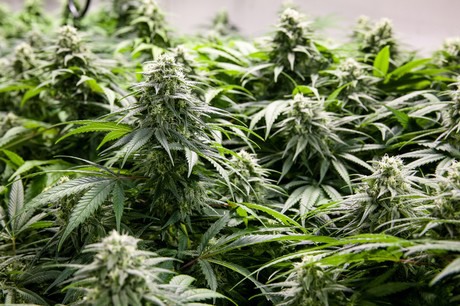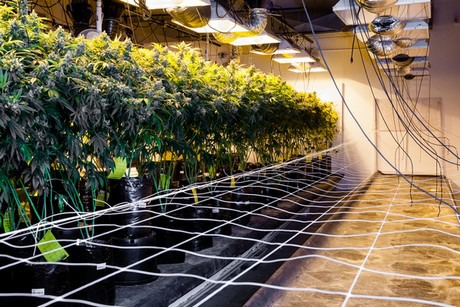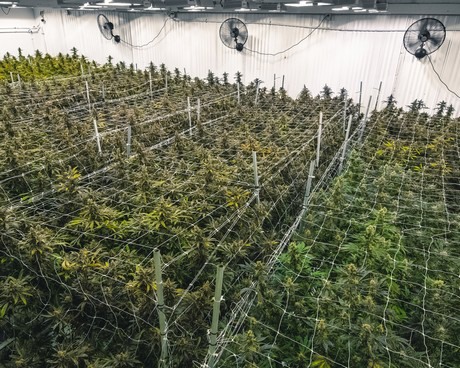In the latest edition of the LED Grow Book by Christopher Sloper, the author touches upon a variety of topics related to large-scale cannabis growing. One chapter specifically explores the different types of grow systems that can be used to grow cannabis.
The first thing that the author points out is that every grow system has its pros and cons: each of them poses different challenges, and it is up to the grower to find a way to overcome them. “In your quest to become Mother Nature, lots of things get thrown at you in the beginning, take your time and learn,” Christopher states.
Growing systems can be classified according to the way in which nutrients are fed to the plants: active/passive, run to waste, and recirculating systems. Active/passive refers to the use of electricity to power the water pumps that bring the nutrients to the plants through sprayers, channels, or feed lines; on the other hands, passive systems do not use any energy, and completely rely on capillary action or gravity.

Run-to-waste systems are commonly used by tomato growers, who irrigate the plants from the top, letting the excessive nutrients be collected in trays placed underneath the pots, or these can be collected directly through a drain hose running out of the grow space. This last aspect leads to the concept of recirculating systems, which re-use the nutrient solutions from the reservoir to feed the plants again. According to Christopher, these systems are usually used with hydroponic set-ups.
“If you ask growers which growing system is best, you’re likely to get seven to ten answers.” Christopher Sloper is clear about it in his latest edition of the LED Grow Book: selecting the best grow system is an important topic and deserves more discussion. “When choosing a growing system, go with what works for you and not what is ‘supposed’ to be the best according to some ‘expert’”, he advises. However, there are some things to pay attention to.
According to Christopher, growing systems can be classified according to the way in which nutrients are fed to the plants: run to waste or recirculating systems, depending on how you treat waste water. Then there’s active/passive systems, referring to the use of electricity to power the water pumps that bring the nutrients to the plants through sprayers, channels, or feed lines. “On the other hand, passive systems do not use any energy, and completely rely on capillary action or gravity.”

Grow Media Considerations: soil vs soilless
When selecting the growing media, the author continues, it is important to take into consideration the cation-exchange capacity (CEC), which “measures how well a grow media retains or binds elemental minerals contained in the nutrients.” Coco coir and peat have high CEC, unlike rockwool and grow rocks. Grow mixes which have a base of coco coir or sphagnum, with perlite for aeration and other additives are considered to be soilless mixes. “The base components of soil are sand, silt and clay,” he explains. “The ratio between these three will dictate if it is sandy, loamy or clay soil.” He continues saying that, most likely, the majority of grow mixes do not have these three ingredients.”
Irrigation types
Each different grow system has a different way of irrigating the plant. For instance, there are systems using subirrigation, which Christopher describes as “the process where water and nutrients are delivered below the surface of the grow media and absorbed upwards through passive wicking.”
Other types are the ebb-and-flow system, also known as flood and drain, where plants’ roots are immersed in nutrient solutions. This system is different from a drip irrigation system, as Christopher points out. Even though they are very similar, in drip irrigation systems “each plant is watered from the top via a drip line or drip ring.”

NFT, aeroponics or Deep Water Culture
Particularly interesting are also the last three grow systems that Christopher explores, namely Nutrient Film Technique, or NFT, aeroponics and Deep Water Culture (DWC).
“NFT systems suspend plants in small plastic baskets above a channel in which a low-volume trickle of nutrient solution constantly flows across their bare roots.” He points out that such a system can provide an optimal balance of water, nutrients, and oxygen. At the same time, since no growing media is used in this system, plants can be very susceptible to interruptions.
Aeroponics, on the other hand, is a type of cultivation method which exposes the roots to nutrients and air. “The roots hang in a chamber, in which nutrient solution is either sprayed directly onto the roots or misted into the air surrounding the roots.”
Lastly, in DWC systems, the roots of the plants are immersed in a solution of highly oxygenated and nutrient-rich water. “The plants are suspended in solution using plastic net pots or something similar,” he explains. “Air is pumped into the DWC reservoir through air pumps and stones, earning this technique the alternate moniker ‘bubbleponics’.”
